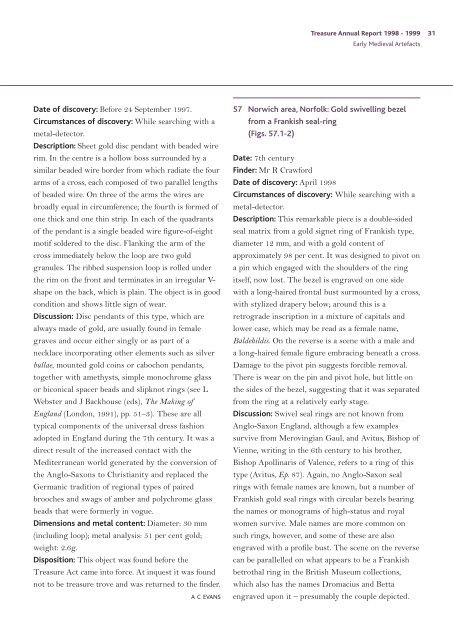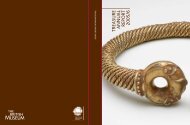Treasure Annual Report 1998-1999 - Portable Antiquities Scheme
Treasure Annual Report 1998-1999 - Portable Antiquities Scheme
Treasure Annual Report 1998-1999 - Portable Antiquities Scheme
Create successful ePaper yourself
Turn your PDF publications into a flip-book with our unique Google optimized e-Paper software.
Date of discovery: Before 24 September 1997.<br />
Circumstances of discovery: While searching with a<br />
metal-detector.<br />
Description: Sheet gold disc pendant with beaded wire<br />
rim. In the centre is a hollow boss surrounded by a<br />
similar beaded wire border from which radiate the four<br />
arms of a cross, each composed of two parallel lengths<br />
of beaded wire. On three of the arms the wires are<br />
broadly equal in circumference; the fourth is formed of<br />
one thick and one thin strip. In each of the quadrants<br />
of the pendant is a single beaded wire figure-of-eight<br />
motif soldered to the disc. Flanking the arm of the<br />
cross immediately below the loop are two gold<br />
granules. The ribbed suspension loop is rolled under<br />
the rim on the front and terminates in an irregular Vshape<br />
on the back, which is plain. The object is in good<br />
condition and shows little sign of wear.<br />
Discussion: Disc pendants of this type, which are<br />
always made of gold, are usually found in female<br />
graves and occur either singly or as part of a<br />
necklace incorporating other elements such as silver<br />
bullae, mounted gold coins or cabochon pendants,<br />
together with amethysts, simple monochrome glass<br />
or biconical spacer beads and slipknot rings (see L<br />
Webster and J Backhouse (eds), The Making of<br />
England (London, 1991), pp. 51–3). These are all<br />
typical components of the universal dress fashion<br />
adopted in England during the 7th century. It was a<br />
direct result of the increased contact with the<br />
Mediterranean world generated by the conversion of<br />
the Anglo-Saxons to Christianity and replaced the<br />
Germanic tradition of regional types of paired<br />
brooches and swags of amber and polychrome glass<br />
beads that were formerly in vogue.<br />
Dimensions and metal content: Diameter: 30 mm<br />
(including loop); metal analysis: 51 per cent gold;<br />
weight: 2.6g.<br />
Disposition: This object was found before the<br />
<strong>Treasure</strong> Act came into force. At inquest it was found<br />
not to be treasure trove and was returned to the finder.<br />
A C EVANS<br />
<strong>Treasure</strong> <strong>Annual</strong> <strong>Report</strong> <strong>1998</strong> - <strong>1999</strong> 31<br />
Early Medieval Artefacts<br />
57 Norwich area, Norfolk: Gold swivelling bezel<br />
from a Frankish seal-ring<br />
(Figs. 57.1-2)<br />
Date: 7th century<br />
Finder: Mr R Crawford<br />
Date of discovery: April <strong>1998</strong><br />
Circumstances of discovery: While searching with a<br />
metal-detector.<br />
Description: This remarkable piece is a double-sided<br />
seal matrix from a gold signet ring of Frankish type,<br />
diameter 12 mm, and with a gold content of<br />
approximately 98 per cent. It was designed to pivot on<br />
a pin which engaged with the shoulders of the ring<br />
itself, now lost. The bezel is engraved on one side<br />
with a long-haired frontal bust surmounted by a cross,<br />
with stylized drapery below; around this is a<br />
retrograde inscription in a mixture of capitals and<br />
lower case, which may be read as a female name,<br />
Baldehildis. On the reverse is a scene with a male and<br />
a long-haired female figure embracing beneath a cross.<br />
Damage to the pivot pin suggests forcible removal.<br />
There is wear on the pin and pivot hole, but little on<br />
the sides of the bezel, suggesting that it was separated<br />
from the ring at a relatively early stage.<br />
Discussion: Swivel seal rings are not known from<br />
Anglo-Saxon England, although a few examples<br />
survive from Merovingian Gaul, and Avitus, Bishop of<br />
Vienne, writing in the 6th century to his brother,<br />
Bishop Apollinaris of Valence, refers to a ring of this<br />
type (Avitus, Ep. 87). Again, no Anglo-Saxon seal<br />
rings with female names are known, but a number of<br />
Frankish gold seal rings with circular bezels bearing<br />
the names or monograms of high-status and royal<br />
women survive. Male names are more common on<br />
such rings, however, and some of these are also<br />
engraved with a profile bust. The scene on the reverse<br />
can be parallelled on what appears to be a Frankish<br />
betrothal ring in the British Museum collections,<br />
which also has the names Dromacius and Betta<br />
engraved upon it – presumably the couple depicted.





